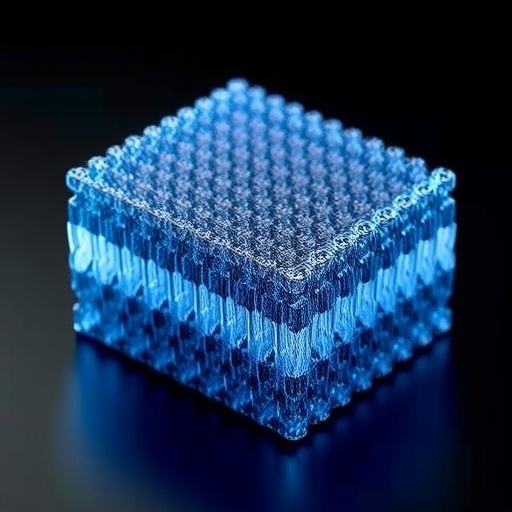In the quest for sustainable and efficient energy storage solutions, researchers have long explored advanced materials to enhance the performance of supercapacitors and batteries. In a groundbreaking study, Ilyas et al. introduce an innovative approach by combining zinc oxide (ZnO) and carbon nanotubes (CNTs) into a freestanding, binder-free paper electrode. This novel design not only improves the electrochemical performance but also adheres to environmental safety standards, addressing the pressing need for sustainable energy technologies.
The incorporation of ZnO and CNTs into a paper matrix presents a transformative step forward in the field of energy storage. Traditional battery and supercapacitor technologies often rely on complex, multi-component systems that include binders and conductive additives, which can hinder performance and increase production costs. By eliminating these elements, the researchers sought to create a more efficient and eco-friendly energy storage solution.
ZnO is well-known for its semiconductor properties and its role as an efficient charge carrier. When combined with carbon nanotubes, which are celebrated for their exceptional electrical conductivity and mechanical strength, the synergy between these materials enhances the overall electrochemical properties. This dual-material approach allows for a highly conductive network that maximizes ion transport, leading to quicker charging and discharging cycles.
.adsslot_N1uTyY3gqp{ width:728px !important; height:90px !important; }
@media (max-width:1199px) { .adsslot_N1uTyY3gqp{ width:468px !important; height:60px !important; } }
@media (max-width:767px) { .adsslot_N1uTyY3gqp{ width:320px !important; height:50px !important; } }
ADVERTISEMENT
Moreover, the freestanding nature of the paper electrodes signifies a substantial departure from conventional electrode designs. The use of paper not only reduces the weight of the electrodes but also contributes to their flexibility and ease of integration into various devices. This aspect is crucial for future applications where space and weight are at a premium, such as in portable electronics and electric vehicles.
Another critical advantage of this research lies in its environmental implications. The development of binder-free electrodes minimizes the use of toxic and environmentally harmful materials often associated with traditional battery production. As the global demand for energy storage solutions escalates, the importance of developing sustainable technologies cannot be overstated. The commitment to using ZnO and CNTs aligns with the ongoing efforts toward greener alternatives in the energy sector.
The researchers conducted a series of electrochemical tests to assess the performance of their developed electrodes. Initial findings aimed to examine the specific capacitance, energy density, and power density of the paper electrodes compared to conventional materials. The results were promising, indicating that the ZnO/CNT paper electrodes exhibited superior performance metrics, marking a potential breakthrough in energy storage technology.
Each of these performance metrics opens doors to new possibilities in energy system designs. For instance, the high specific capacitance achieved by the new electrodes implies longer-lasting energy storage capabilities. This can be particularly advantageous for applications requiring rapid energy discharge, such as in electric vehicles and renewable energy systems. By enhancing the charge retention of these energy storage devices, the research team emphasizes the broader potential impact of their work.
The potential economic benefits of this research cannot be ignored either. As industries explore alternatives to expensive and scarce materials, the use of readily available resources such as paper combined with nanomaterials could pave the way for more cost-effective energy storage solutions. This aspect could significantly lower production costs, ultimately benefiting consumers and manufacturers alike.
Researchers acknowledge that while the results are promising, further testing and optimization are needed before commercialization can be achieved. Future work will likely aim at scaling up the manufacturing process while maintaining the efficiency and performance of the electrodes. By refining production techniques, the transition from laboratory research to real-world applications can be accelerated.
In summary, the research led by Ilyas et al. stands at the forefront of a technological shift in energy storage devices. Their innovative combination of ZnO and carbon nanotubes into a freestanding binder-free paper electrode offers a glimpse into the future of environmentally safe energy solutions. Enhanced performance metrics coupled with sustainability mark a pivotal moment in the development of next-generation energy storage systems.
As the scientific community continues to explore various nanomaterials and combinations for energy devices, the groundwork laid by this research will likely inspire new studies and advancements. These efforts could usher in a new age of smart energy solutions, capable of meeting the growing demands of our modern, energy-dependent world.
With a deepened understanding of material properties and electrochemical interactions at play within these systems, Ilyas et al. have sparked interest in a new category of energy storage devices. Their work encourages a collaborative approach among researchers, engineers, and industry experts to harness the full potential of advanced materials, ultimately leading to cleaner energy solutions that benefit society at large.
As we strive to combat climate change and promote sustainability, innovations like these are crucial. They present us with actionable pathways toward cleaner alternatives, emphasizing efficiency, cost-effectiveness, and environmental consciousness. The future of energy storage may very well rest on the shoulders of such pioneering studies.
Subject of Research: Advanced energy storage solutions using ZnO and carbon nanotubes.
Article Title: ZnO and carbon nanotubes-based freestanding binder-free paper electrodes for environmentally safe energy storage devices.
Article References:
Ilyas, S., Sultana, I., Kainat, F. et al. ZnO and carbon nanotubes-based freestanding binder-free paper electrodes for environmentally safe energy storage devices. Ionics (2025). https://doi.org/10.1007/s11581-025-06595-5
Image Credits: AI Generated
DOI: https://doi.org/10.1007/s11581-025-06595-5
Keywords: energy storage, ZnO, carbon nanotubes, sustainability, electrodes
Tags: advanced materials for energy storagebinder-free energy storage systemseco-friendly energy storage solutionsefficient ion transport in batterieselectrochemical performance enhancementenvironmental safety in energy technologiesgreen technology in energy systemshigh conductivity and mechanical strength materialsinnovative paper electrode designsustainable supercapacitors and batteriestransformative energy storage solutionszinc oxide and carbon nanotube technology





